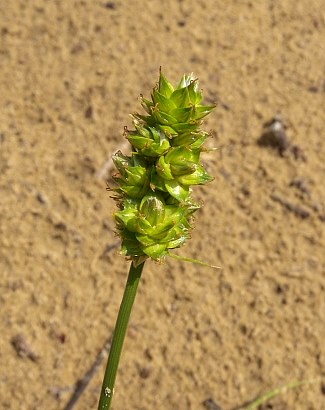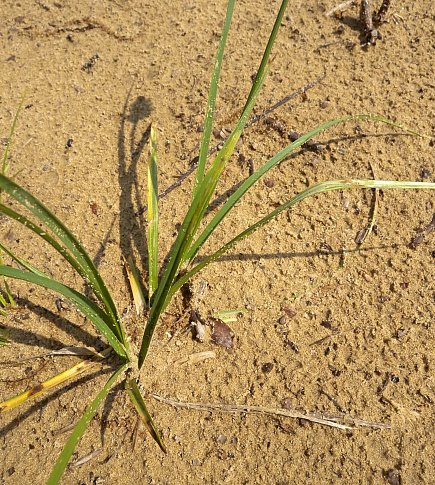 length, 2.0-3.0 mm. across, and
plano-convex; they are ovate-orbicular in shape, tapering to a short
beak with 2 minute teeth. For the typical variety of Sand Sedge, the
perigynia have several longitudinal veins along their outer sides,
while for var. enervis,
the outer sides of the perigynia are veinless.
The perigynia are glabrous and they vary in color from light green to
yellowish brown. The pistillate scales are about the same length as the
perigynia or a little shorter; they are ovate in shape, tapering to
short awn-like tip. The pistillate scales have green central veins and
membranous margins. Each female floret has a pair of yellowish brown to
reddish brown
stigmata. At the base of each inflorescence, there is a slender leafy
bract
up to ¾" in length; one or two additional bracts of smaller size may
occur within the inflorescence. The blooming period occurs from late
spring to early summer, lasting about 1-2 weeks. The florets are
cross-pollinated by the wind. Afterwards, the mature perigynia
disarticulate from the spikelets and they are blown about by the wind.
Individual achenes are about 2.0 mm. in length, ovoid-orbicular in
shape, and somewhat flattened, tapering abruptly to a small point at
their bottoms.. The root system is short-rhizomatous and
fibrous.
length, 2.0-3.0 mm. across, and
plano-convex; they are ovate-orbicular in shape, tapering to a short
beak with 2 minute teeth. For the typical variety of Sand Sedge, the
perigynia have several longitudinal veins along their outer sides,
while for var. enervis,
the outer sides of the perigynia are veinless.
The perigynia are glabrous and they vary in color from light green to
yellowish brown. The pistillate scales are about the same length as the
perigynia or a little shorter; they are ovate in shape, tapering to
short awn-like tip. The pistillate scales have green central veins and
membranous margins. Each female floret has a pair of yellowish brown to
reddish brown
stigmata. At the base of each inflorescence, there is a slender leafy
bract
up to ¾" in length; one or two additional bracts of smaller size may
occur within the inflorescence. The blooming period occurs from late
spring to early summer, lasting about 1-2 weeks. The florets are
cross-pollinated by the wind. Afterwards, the mature perigynia
disarticulate from the spikelets and they are blown about by the wind.
Individual achenes are about 2.0 mm. in length, ovoid-orbicular in
shape, and somewhat flattened, tapering abruptly to a small point at
their bottoms.. The root system is short-rhizomatous and
fibrous.Cultivation: The preference is full or partial sun, mesic to dry conditions, and sandy soil.
Range & Habitat: The native Sand Sedge is occasional throughout Illinois (see Distribution Map). Habitats include upland sand prairies, sand dunes, rocky upland woodlands, areas along railroads, and sandy fields. There is a preference for upland habitats with barren soil and reduced competition from other kinds of ground vegetation.
Faunal Associations: Various insects feed on sedges (Carex spp.) in upland areas. These species include such common aphids as Rhopalosiphum maidis (Corn Leaf Aphid), Schizaphis graminum (Spring Grain Aphid), and Sipha flava (Yellow Sugarcane Aphid). An introduced aphid, Iziphya flabella, has been found on Sand Sedge (Carex muehlenbergii) specifically in Mason County, Illinois. Many grasshoppers feed on the foliage of upland sedges and other plants. These species include Arphia pseudonietana (Red-Winged Grasshopper), Melanoplus angustipennis (Narrow-Winged Sand Grasshopper), Spharagemon collare (Mottled Sand Grasshopper), and Trachyrhachys kiowa (Kiowa Grasshopper). See the Grasshopper Table for a more complete list of these species. Some billbugs also feed on sedges and similar species; they include Sphenophorus callosus (Southern Corn Billbug), Sphenophorus costicollis (Sedge Billbug), and Sphenophorus costipennis. The larvae of billbugs usually burrow through the stalks of these plants. Among vertebrate animals, upland gamebirds and granivorous songbirds feed on the seeds of upland sedges. These species include the Greater Prairie Chicken, Ring-Necked Pheasant, Wild Turkey, Horned Lark, Snow Bunting, and others (see the Bird Table for more complete list of these species). A small mammal, the Prairie Vole, feeds on either the foliage or seeds.

Photographic Location: A sand dune at the Oak Openings Nature Preserve in NW Ohio.
Comments: Sometimes the scientific name of this sedge is spelled Carex muhlenbergii. Other common names of this sedge are Muhlenberg's Sedge and Sand Bracted Sedge. The typical variety of Sand Sedge is more common in Illinois than var. enervis. Mohlenbrock (1999/2011) now classifies var. enervis as a distinct species, or Carex plana. In the past, Carex austrina (Southern Sedge) was regarded as a variety (var. austrina) of Sand Sedge, but it is currently classified as a distinct species. Considering the variations in taxonomy around this species, it is not surprising that this sedge can be difficult to distinguish from other similar sedges, such as Carex gravida (Heavy Sedge) or Carex mesochorea (Midland Sedge). However, it is more likely to be found in sandy habitats than these latter two species.